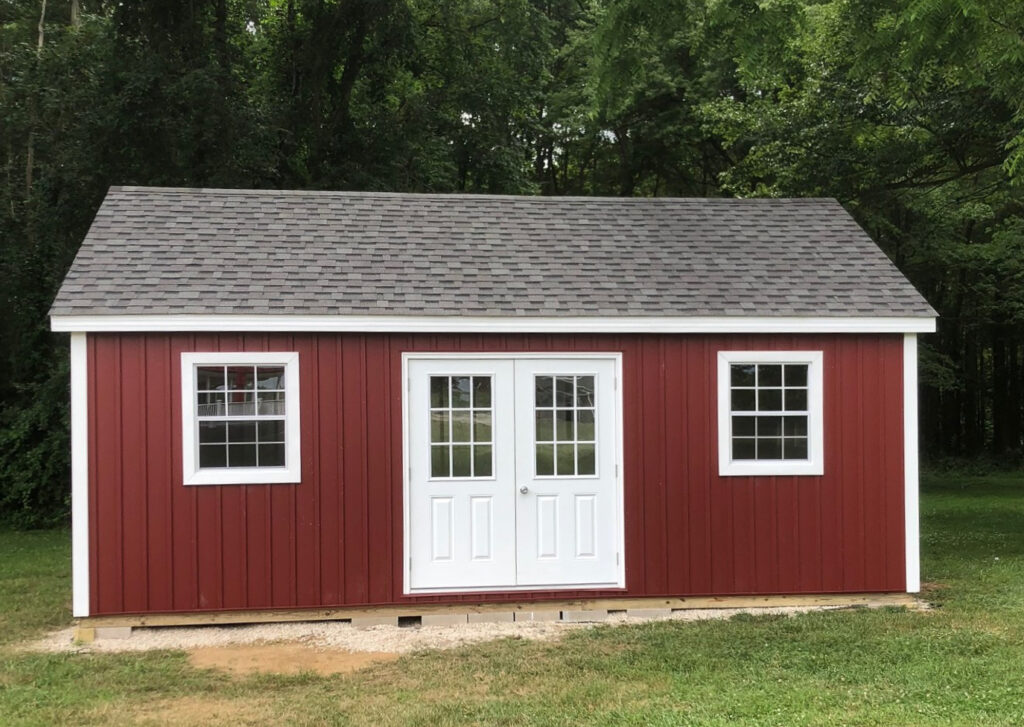
When shopping for sheds, one of the first things you notice is the color and look of the siding. (Like the blue vinyl on the Cape Shed pictured above.) Regardless of how well a shed is built on the inside, it’s the outside that catches your eye. And it’s the outside that you’ll be seeing for years to come.
This means that when you’re choosing a shed, you need to put some thought into your siding options.
Our sheds are available with two choices of siding: vinyl and wood. Knowing the difference between these options will help you make a decision that you’ll be happy with in the years ahead.
Wood siding is standard on our sheds, while vinyl is available as a slightly more expensive upgrade. In this post, we’ll look at the differences between them and explain why we think vinyl is the better option.
Comparing products
Before comparing wood and vinyl siding, we first need to explain what we’re talking about. The wood siding we use is LP SmartSide, an engineered product made by Louisiana-Pacific Corporation. This siding is composed of small wood fibers similar to OSB (oriented strand board). These fibers are impregnated with a mix of waxes, resins, and compounds that help resist insect and moisture damage.
LP SmartSide is available in various styles. For our sheds, we’ve chosen to use LP SmartSide Panel with SilverTech. These 4×8 sheets have a radiant barrier on the interior-facing side. This barrier helps to reduce heat inside the shed and also brightens up the interior. The outside of the panels has a real-wood feel and is made with narrow vertical channels to add interest and simulate the look of individual boards.
For vinyl siding, we use ProVia Double 4” Lap. Even though we are building sheds and not homes, we’ve still opted for this mid- to high-grade siding, the same kind of siding used for homes.

Appearance
When it comes to appearance, there really isn’t a right or wrong answer. People prefer different things, and that’s one reason we offer these two looks. From a distance, both SmartSide and vinyl have a traditional look. Up close, you’ll see that SmartSide looks more wood-like (because it is).
Maintenance
Preferences vary in how siding looks, but when it comes to maintenance, we think vinyl is the clear winner. Since SmartSide is wood-based, there is always the possibility that it might be damaged by water that finds its way inside. This is most likely if the paint degrades over time. Although the interior is treated with resistant compounds, it is still made of wood!
For this reason, SmartSide should be monitored and inspected. You should also expect that it may need paint every 7 or 8 years to maintain a solid seal against rain and moisture.
On the other hand, vinyl is nearly maintenance-free. Sometimes it can develop moss if it’s located in a moist, shady area without drying breezes. But this is easily washed off. Other than that, vinyl needs no maintenance and will last for many years.
Durability
For siding to protect your home, it has to withstand the elements. SmartSide and vinyl are both resilient and can withstand most hard impacts and various weather events.
Like SmartSide, vinyl is flexible enough to absorb most things that are thrown at it. If it is damaged by a flying object, it is easier to replace a piece of siding than it would be to replace a piece of SmartSide. (Getting a perfect color match could be challenging, however.) Vinyl is engineered to withstand high winds, extreme temperatures, and impacts from hail or other airborne debris.
Additionally, vinyl is resistant to moisture and will never rot, warp, or crack – an issue often faced with wood products like LP SmartSide. This ensures that your shed’s exterior remains in great shape for years.
Both SmartSide and vinyl are able to handle the extremes of weather that are common to our area.

Cost and value
Sheds with vinyl siding will initially cost more. This is partly due to extra materials needed in their construction. In a shed sided with SmartSide, the panels serve as the walls of the shed. When using vinyl, however, the shed walls are built from plywood and then covered with vinyl. This results in an additional layer of materials.
In spite of the extra initial costs, we think that the long-term durability and lack of maintenance required for vinyl easily offset the extra expenses.
Conclusion
In the end, the choice is yours. Certainly, when it comes to appearance, the playing field is equal and you can be the referee. But when looking at maintenance, durability, and long-term costs, we think vinyl siding is the clear winner.
Take a minute to browse our in-stock sheds or see the garages we offer.
Still have a question? We’re here to help!
